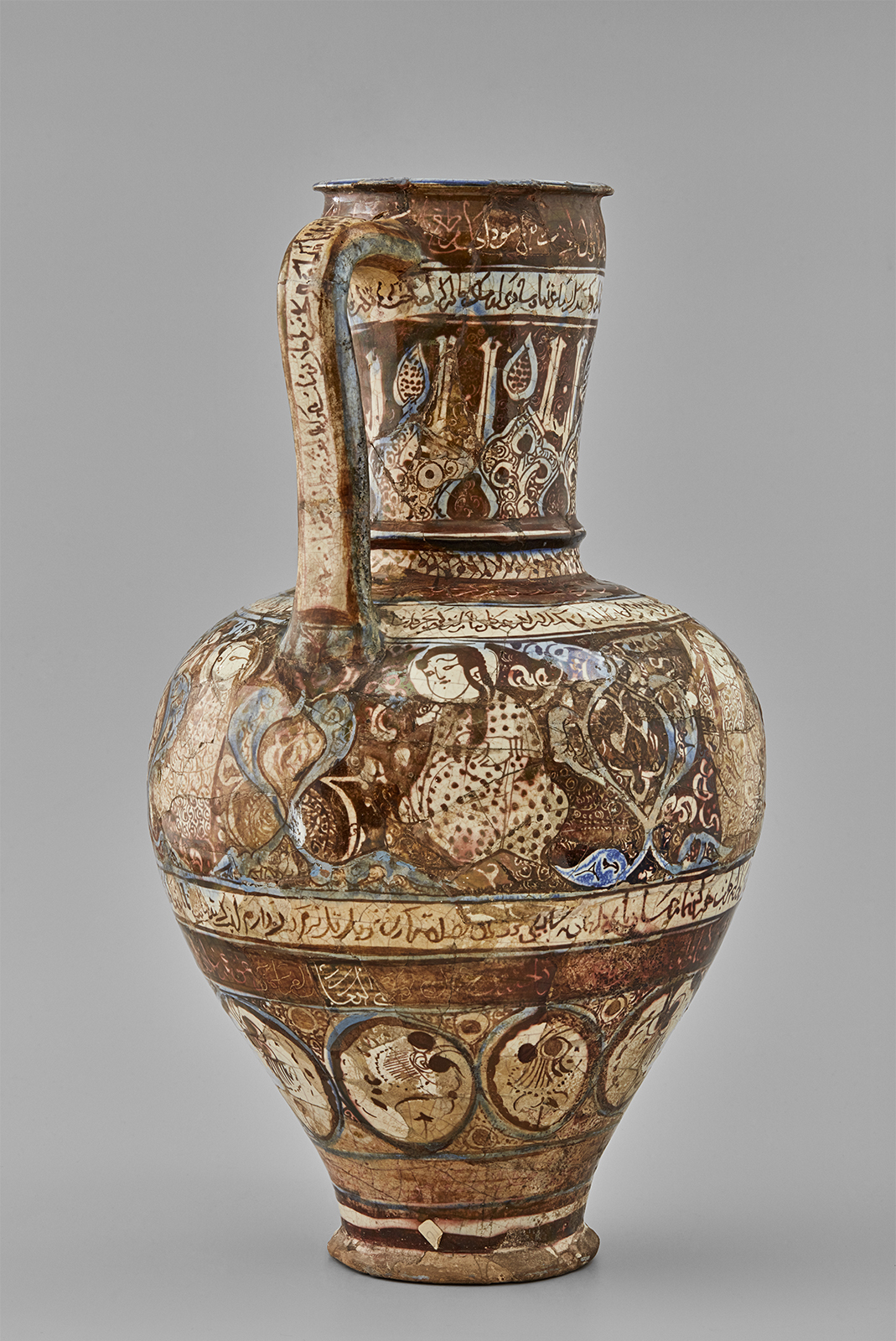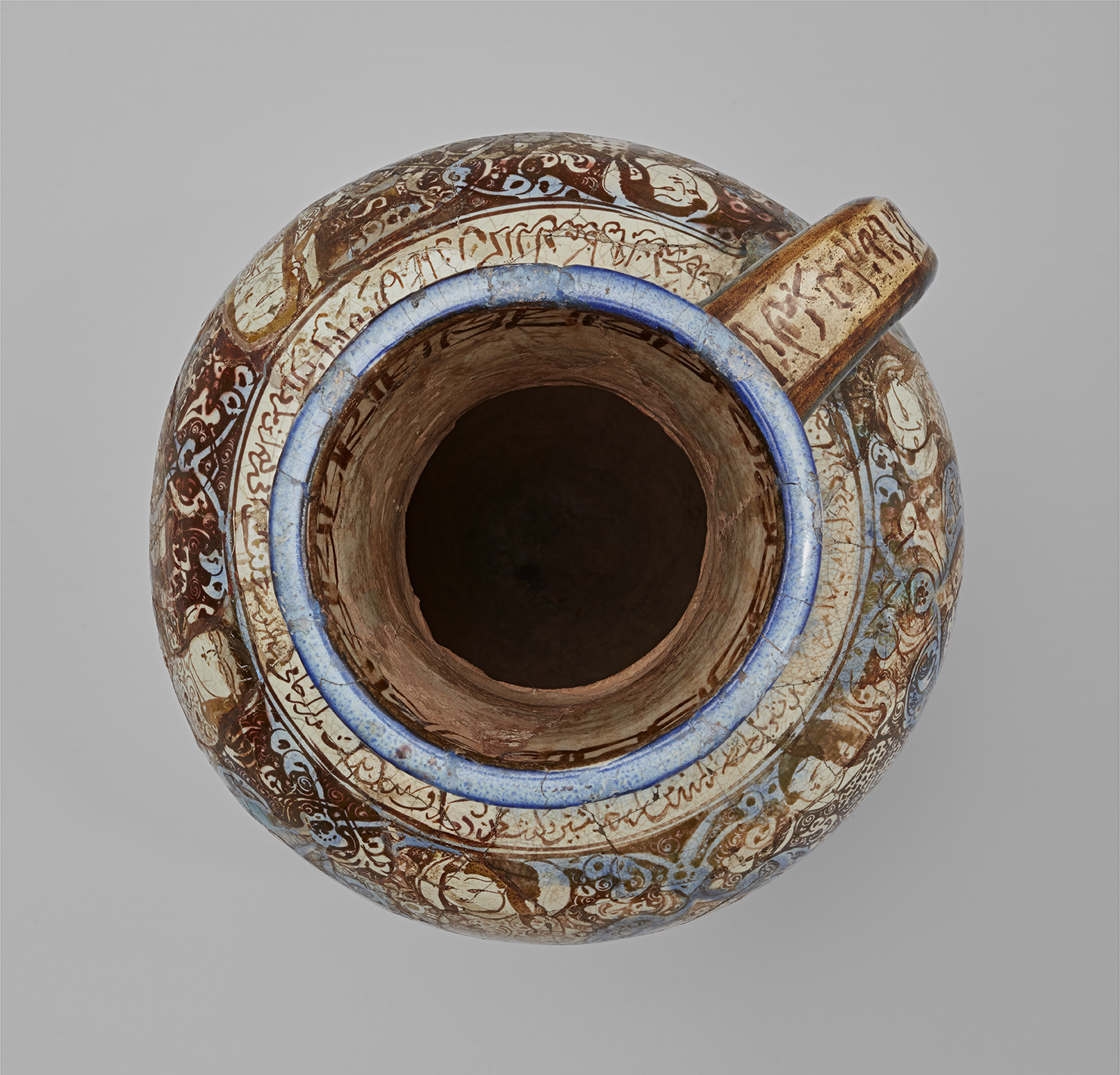Click on the image to zoom
Lustre-Painted Ewer
- Accession Number:AKM763
- Place:Iran, Kashan
- Dimensions:45.7 cm
- Date:12th–13th century
- Materials and Technique:fritware, lustre-painted
This ewer was produced in Kashan, a city in Iran known for ceramic production between the 11th and 13th centuries. Kashan vessels were made of fritware, a mixture of minerals (namely glass and clay). The fritware surface was frequently painted over with lustre, which imitated the sheen of a metal such as bronze or gold.[1] They often depict scenes of elite leisure activities such as hunting, feasting, and dancing.[2] This jug includes a slender handle, bulbous lower body, and rimmed opening, echoing the design of metal ewers used to store liquids of various kinds.
Further Reading
The technique of lustre painting first emerged in Iraq in the 9th century.[3] Used for ceramic decoration, lustre paint was made by compounding metal oxides to create bright yellows, browns, and other colours. Before the paints’ application, the vessel in question had already gone through the process of a first firing through which the ceramic body would be hardened.[4] The lustre would then be applied, followed by a second firing to fix the colour onto the ceramic surface.[5] In the 12th and 13th centuries, this particular method of ceramic production and painting was introduced to cities in Iran, such as Rayy, and Kashan, where this ewer is thought to have been produced.[6]
The ewer is painted with brown and touches of blue pigment against a white body. Five bands of inscriptions, written in cursive (naskh) script, punctuate the body of the vessel; two of these are scratched through the lustre surface, while the remaining three are painted directly onto the white body of the vessel. A Kufic inscription in large white lettering runs along the upper band of the ewer’s neck. The handle also is painted in a similar colour scheme and bears an inscription along its edge.[7] These types of inscriptions frequently incorporated well wishes to the object’s owners, as well as excerpts from poetry.
In most Kashan wares, the lustre is only applied to the ceramic surface to allow for inscriptions, as well as to produce contours of the vegetal decorations and the seated figures. The white surface of the vessel was generally left blank in order to emphasize the colour contrast. This ewer also features geometric motifs painted in cobalt blue, perhaps in imitation of blue and white Chinese porcelain.[8]
A row of figures seated against a backdrop of blue scrolling vine motifs populate the upper half of the body. These figures are dressed in white and brown robes dotted with geometric patterns and are portrayed with long dark tresses and rounded facial features, such as arched eyebrows, almond shaped eyes, and full cheeks. These facial traits belong to a category of portraiture referred to as “moon-face” (mah-ruy), considered the paradigm of beauty and love in medieval Persian literature.[9] Representations of “moon-faced” figures are frequently found in Persian illustrated manuscripts and ceramics such as this jug.[10] Moreover, the object’s blue and brown lustre catches and reflects light, acting as a potential metaphor for the moon’s light-emitting qualities.[11]
In addition to inscriptions and vegetal motifs, the compositions on Kashan wares often depicted lavishly dressed figures engaged in pursuits such as hunting, feasting, or watching dance or musical performances. The figures seated in a circle on this ewer from the Aga Khan Museum Collection may allude to a courtly event where attendees would enjoy a meal while experiencing a performance of some kind. The iconography of courtly enjoyment, referred to as bazm wa razm or “feasting and fighting,” can also be found widely in other media in the medieval Persian world, including metalwork.[12]
— Michelle al-Ferzly
Notes
[1] Watson, Ceramics from Islamic Lands, 114.
[2] Ibid., Persian Lustre Ware, 45.
[3] Grube, “The Art of Islamic Pottery,” 211.
[4] Allan, “Abū’l Qasim’s Treatise on Ceramics,” 114–5; 119–20.
[5] Ibid.
[6] Grube, “The Art of Islamic Pottery,” 215.
[7] Welch, Collection of Islamic Art, 1972.
[8] Grube, “The Art of Islamic Pottery,” 211.
[9] Melikian-Chirvani, Le monde iranien et l’Islam, 38.
[10] Phillip Jodido et al, Pattern and Light, 50.
[11] Gruber, The Moon, 178–79.
[12] Canby, The Shahnama of Shah Tahmasp, 21-24; 50; With regards to bazm wa razm, see also a 2015 exhibition on the subject at the Metropolitan Museum of Art, https://www.metmuseum.org/exhibitions/listings/2015/bazm-and-razm.
References
Allan, James. “Abū’l Qasim’s Treatise on Ceramics.” Iran 11 (1973): 111–20. DOI: 10.2307/4300488
Canby, Sheila R. The Shahnama of Shah Tahmasp: The Persian Book of Kings. New Haven: Yale University Press, 2014. ISBN: 9780300194548
Grube, Ernst. “The Art of Islamic Pottery.” The Metropolitan Museum of Art Bulletin 23.6 (1965): 209–28. DOI: 10.2307/3258167
Watson, Oliver. Persian Lustre Ware. London: Faber & Faber, 1985. ISBN: 9780571132355
---. Ceramics from Islamic Lands. London: Thames & Hudson, 2006. ISBN: 9780500976340
Welch, Antony. Collection of Islamic Art, Prince Sadruddin Aga Khan. Geneva: Château de Bellerive, 1972.
Note: This online resource is reviewed and updated on an ongoing basis. We are committed to improving this information and will revise and update knowledge about this object as it becomes available.








